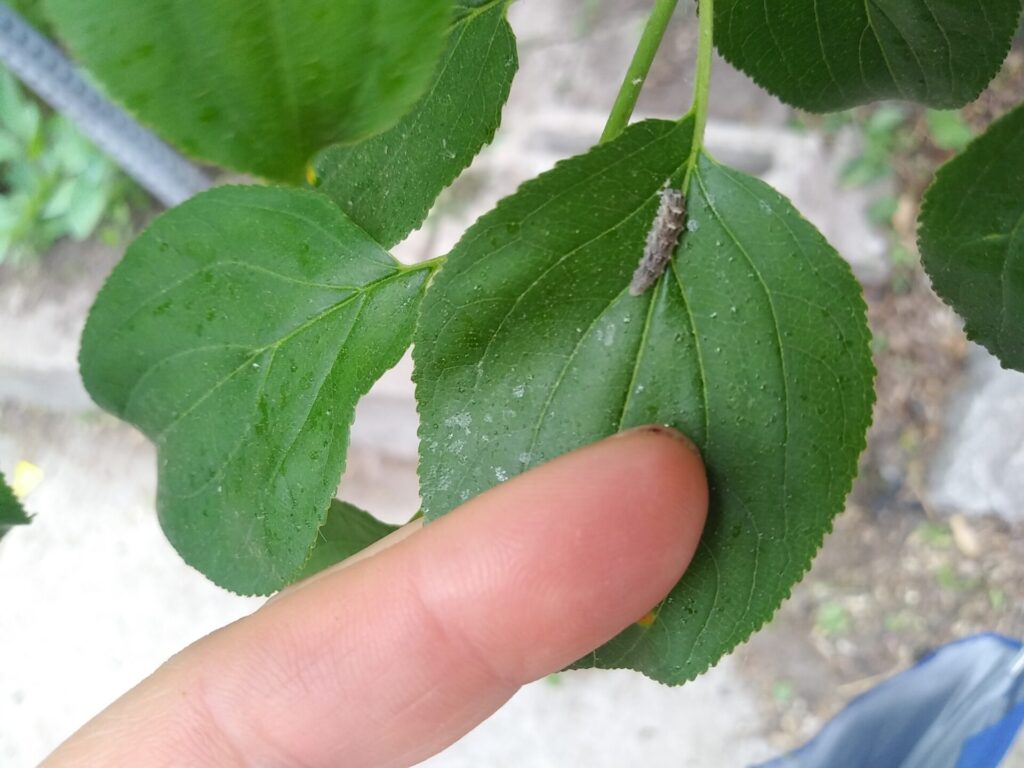
Hello, first thank you very much to the person who answered my question yesterday about a young birch tree with an aphid infestation and now the appearance of tiny caterpillars about 1-2cm long. In the photo I sent yesterday it was hard to discern the caterpillar’s details — also my camera is not that great. Here is a shot of only the caterpillar. Any idea what it may be? The previous Master Gardener couldn’t see it well enough to confirm, but thought it could be a a gypsy moth instead of a beneficial caterpillar. I cannot see any red dots or marks on the caterpillars, nor any spiny hairs, at least not with the naked eye. From a brief internet search I understand that those are trademarks of gypsy moth caterpillars.
Thank you for contacting the Toronto Master Gardeners with regards to your birch tree.
It is difficult to clearly make out the caterpillar in your photograph, however I believe I do see some tiny bumps on its back. We are not entomologists, however due to the explosion in the gypsy moth population this year it could very likely be a young gypsy moth larva. Gypsy moths feed on the leaves of oaks along with other preferred hosts trees which include apple, aspen, basswood, birch, willow and crabapple.
The following information on the gypsy moth life cycle and it’s control is from one of our earlier posts:
“Every 7-10 years there’s an increase in the gypsy moth population – the moth eggs are found on tree bark/trunks and in mid to late April emerge as larvae (caterpillars), which climb into crowns of trees and eat the leaves. Next is the pupal stage (June to mid-July) and finally the adult moth will emerge to lay eggs. You can intervene at most stages of the insect’s life cycle to help control the infestation:
- Scrape egg masses from trunks and branches until around now (it’s April 25) – often eggs are laid quite high up in the trees, so may be difficult to find. Drop them in a bucket of soapy water so they drown or dispose of them in a sealed container in the garbage. Don’t just discard them on the ground, they could hatch.
- During the early caterpillar stage, biological pesticides can be used (until mid-June at the latest – it’s only effective against the caterpillar stage). For example, a bacterium that is toxic to the young gypsy moth caterpillars is Bacillus thuringiensis kurstaki (Btk) – it is found naturally in the soil. Contact your municipality to ask about their gypsy moth control program, which may include spraying in certain areas. You could also consult a certified pest control expert if the area you need to treat is large.
- To get rid of late stage caterpillars, wrap 45 cm (18 inch) wide burlap bands around tree trunks at around chest height. Use string and tie it around the centre of the burlap. This will prevent the larvae from reaching higher areas of the trees as the critters will hide underneath the bands – check daily and remove them by hand and destroy them by dropping them in a bucket of soapy water so they drown. Make sure you wear gloves as caterpillars are hairy and can cause allergic-type reactions.
- The pupae (June to mid-July) can be removed by hand.
- Don’t bother trying to get rid of the moths once they reach the adult stage in July to August – the insects are much more vulnerable during the other life stages.
- The Ontario Ministry of the Environment and Energy also provides an overview of the gypsy moth , the damage it causes and how you can help control it. Gypsy moth.
- Ontario’s Invading Species Awareness Program has an excellent website, and you can download fact sheets from the site. As well, they encourage you to report gypsy moth sightings to the Invading Species Hotline. See Gypsy moth .”
Good Luck with your birch tree.

